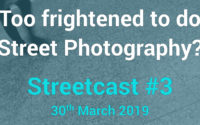Camera choice, personal style and types of work – Streetcast #5 – 13th April 2019
So many of todays camera systems are excellent in terms of sensor and optical quality. Even some cameras from earlier phases of digital photography, still hold their own for professional use today. Why we choose one camera over another is important, so I thought I would share my thoughts and experiences.
My father unfortunately has difficulties with his eyes and last year threw a whole collection of his cameras my way. This was personally sad but at the same time an interesting opportunity. He never cared about a particular brand, so I got Canon, Panasonic and Fujis to play with.
My personal choice
I personally choose Nikon DSLRs because I could use Nikon’s own manual older lenses directly on their digital bodies. Even the pro-glass from as far back as the 80’s would work on even the crop sensor entry level digital cameras. As I understand it Canon changed things between analogue and digital such that adapters would be needed for their old glass on their new cameras.
Old manual glass was attractive because it is pro-quality at an affordable price and manual. Manual being my most comfortable photographic interface because that is how I learnt.
I dare say that my choice would be rejected and criticised as stupid, backwards or illogical. But it works for me and I assume I am not that unique that at least someone else would also run with it. Many however would probably not.
My kit aside, still the idea and thrill of picking up something different and seeing what it can do, does have a mystical draw. So getting the cameras from my father was still an enthralling concept.
My anticipation of new doors being opened, and new opportunities being available was high. The reality however was not.
New cameras, new problems
One of the cameras was the Fujifilm X-E1 a fine camera, sensor and optically speaking, but totally unworkable for me.
The EVF is a case in point. An EVF is a horrid interface for my eyes. I think my brain calculates an image faster than the refresh rate, so I am left with a disturbed view compared to an optical viewfinder. The update speed also has such a lag that the capture of street is awkward. The pixelation is still visible and not accurate enough for manual focus. Zoom to focus looses the whole frame which so important for street and candid photography.
I cleaned it, got new batteries, added thumb grip, shutter button cap and shipped it back to my father to use. This is probably the only camera he can effectively use today. So the experiment and play was far from a loss. He is back albeit in a more limited fashion.
All this goes to show that the camera choice and ergonomics is about us the photographer and not the camera. A camera is not good or bad today, it is suitable or not suitable for the photographer.
We each need to find a setup that is the best ergonomic implementation of “our way” and then we can make the camera sing!
Circumstances matter too
In the cameras my father gave me there were two that do work for me, but. And this brings me to the second part. For certain circumstances and specific reasons.
X100
The Fujifilm X100 is a magic camera. Not because of the lens choice, sensor size or other obvious characteristic. Considering the fact that an Infrared Filter works on these cameras without the need to “remove a built in filter”, I think they capture some Infrared into the raw image. Something I think other manufacturers don’t. I don’t know how film worked, but I can assume that film is logarithmic and it would not surprise me if real film took on some IR and perhaps UV effect into the emulsion. This could explain how Fujifilm’s film look is so special and so similar to traditional film.
That aside why the X100? Well I traditionally like heavy cameras. With my first manual camera it was a brick, but this allowed me to brace and take 1/15 sec exposures hand held. So I have a natural aversion to small and light. But at times this must be compromised.
The X100 has a really good lens, great visual character and is not obtrusive. In cases where I am going shopping, to a more conservative event or even a business meeting this camera works.
5D Classic
The second was the Canon 5D classic or mark 1. Like the X100 this camera too has a filmy look that feels authentic. It is simple and heavy, things I like, but at the same time has a nice ergonomic style. There is space for fingers and thumb without having to take care of pressing erroneous buttons.
I like this camera so much I got the battery pack, two batteries, the 40mm 2.8 STM lens and it is a big heavy street “brick”. The images are great and the lack of phallic glass sticking out the front makes it easy in a crowd.
Two thing matter
So in my thinking two things matter. How we like to work and how we need to work. The first being the personal style and interface that works for us to control the camera. The second being the appropriateness for the camera in the given environment or circumstance.
It is clear that the brand, age or “status symbol effect” of a camera setup is irrelevant. Taking offence that someone else selected a different brand is meaningless. After all they simply choose the best tool for themselves.



